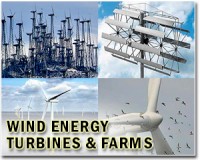 |
Newark DE (SPX) Apr 14, 2010 The energy needs of the entire human population could potentially be met by converting wind energy to electricity. While offshore wind power resources are abundant, wind turbines are currently unable to provide steady power due to natural fluctuations in wind direction and strength. Offshore wind power output can be made more consistent by choosing project development locations that take advantage of regional weather patterns and by connecting wind power generators with a shared power line, according to a paper by researchers from the University of Delaware and Stony Brook University published in the April 5 issue of the Proceedings of the National Academy of Sciences. "Making wind-generated electricity more steady will enable wind power to become a much larger fraction of our electric sources," said the paper's lead author Willett Kempton, UD professor of marine policy in the College of Earth, Ocean, and Environment and director of its Center for Carbon-free Power Integration. The research team - which also included UD alumnus Felipe Pimenta, UD research faculty member Dana Veron, and Brian Colle, associate professor in the School of Marine and Atmospheric Sciences at Stony Brook University - demonstrated thoughtful design of offshore wind power projects can minimize the impacts of local weather on power fluctuations. The researchers analyzed five years of wind observations from 11 monitoring stations along the U.S. East Coast from Florida to Maine. Based on wind speeds at each location, they estimated electrical power output from a hypothetical five-megawatt offshore turbine. After analyzing the patterns of wind energy among the stations along the coast, the team explored the seasonal effects on power output. "Our analysis shows that when transmission systems will carry power from renewable sources, such as wind, they should be designed to consider large-scale meteorology, including the prevailing movement of high- and low-pressure systems," Kempton said. Colle explained the ideal configuration. "A north-south transmission geometry fits nicely with the storm track that shifts northward or southward along the U.S. East Coast on a weekly or seasonal time scale," he said. "Because then at any one time a high or low pressure system is likely to be producing wind (and thus power) somewhere along the coast." The researchers found each hypothetical power generation site exhibited the expected ups and downs, but when they simulated a power line connecting them, the overall power output was smoothed so that maximum or minimum output was rare. In the particular five-year period studied, the power output of the simulated grid never completely stopped. No wind turbines are presently located in U.S. waters, although projects have been proposed off the coasts of several Atlantic states. This research could prove useful as project sites are selected and developed. Reducing the severity of wind power fluctuations would allow sufficient time for power suppliers to ramp up or down power production from other energy sources as needed. Solutions that reduce power fluctuations also are important if wind is to displace significant amounts of carbon-emitting energy sources, the researchers said.
Share This Article With Planet Earth
Related Links University of Delaware Wind Energy News at Wind Daily
 Wind energy projects receive credit boost
Wind energy projects receive credit boostOttawa (UPI) Mar 25, 2009 Wind energy projects run by Wind Works Power Corp. received a boost with a $10 million credit facility that will go toward developing capacity in Canada, the United States and Europe. Wind Works Power Corp. said it was pledged the line of credit after an investment agreement signed with Kodiak Capital Group LLC of New York. The agreement covers a a $10 million equity line of cre ... read more |
|
| The content herein, unless otherwise known to be public domain, are Copyright 1995-2010 - SpaceDaily. AFP and UPI Wire Stories are copyright Agence France-Presse and United Press International. ESA Portal Reports are copyright European Space Agency. All NASA sourced material is public domain. Additional copyrights may apply in whole or part to other bona fide parties. Advertising does not imply endorsement,agreement or approval of any opinions, statements or information provided by SpaceDaily on any Web page published or hosted by SpaceDaily. Privacy Statement |